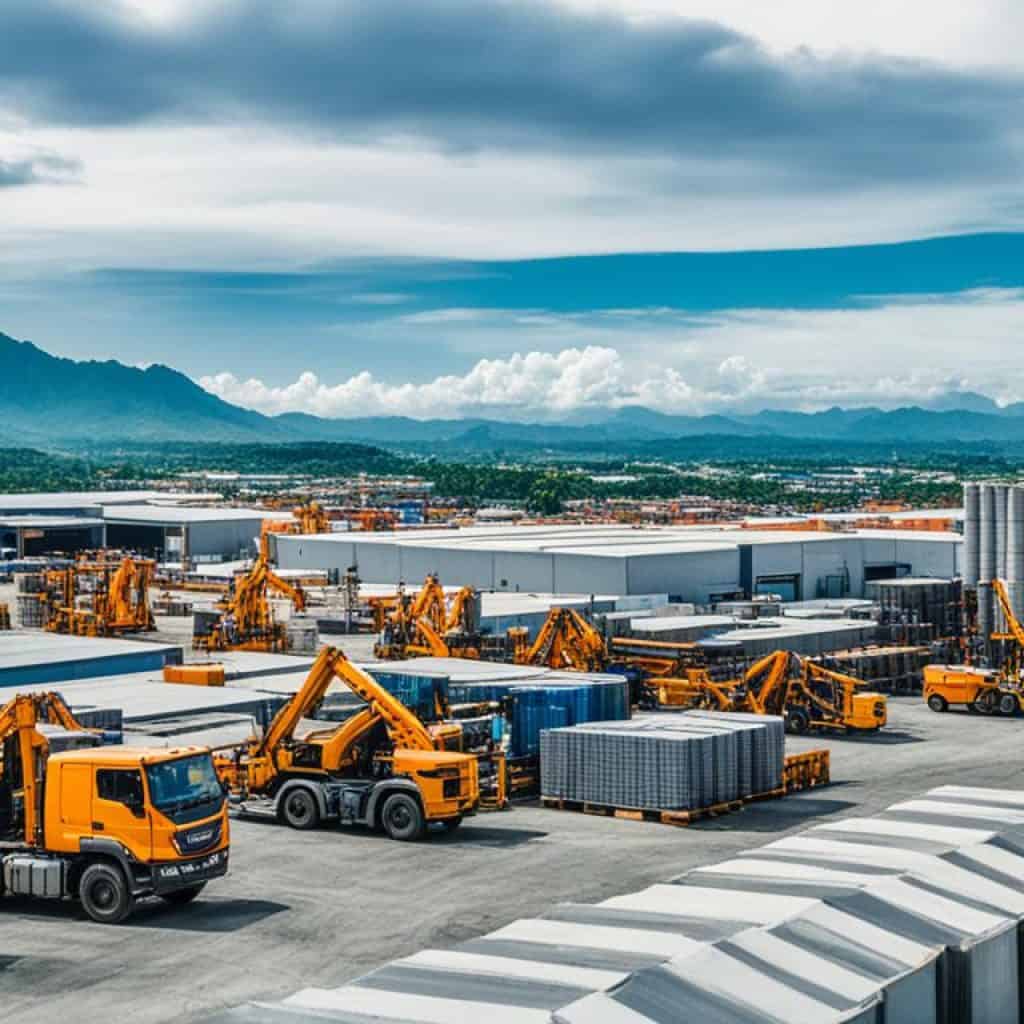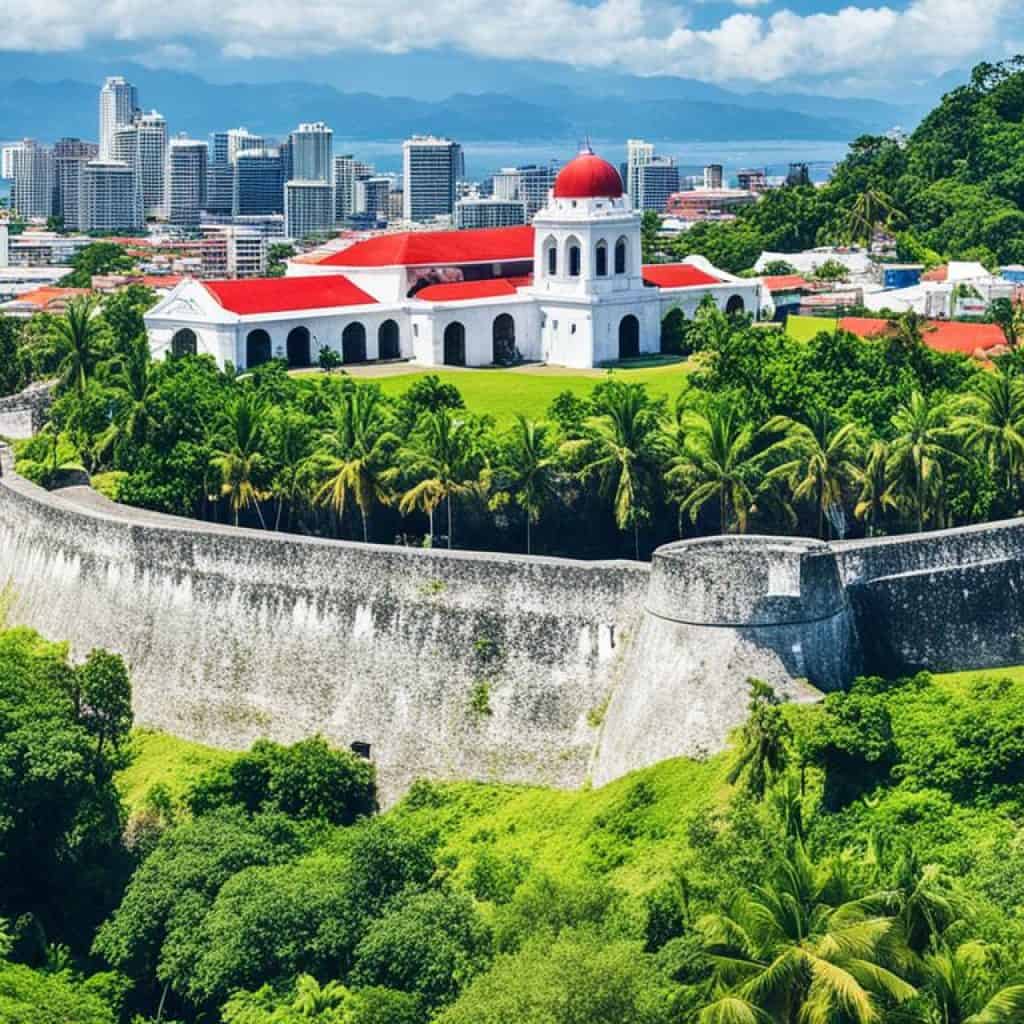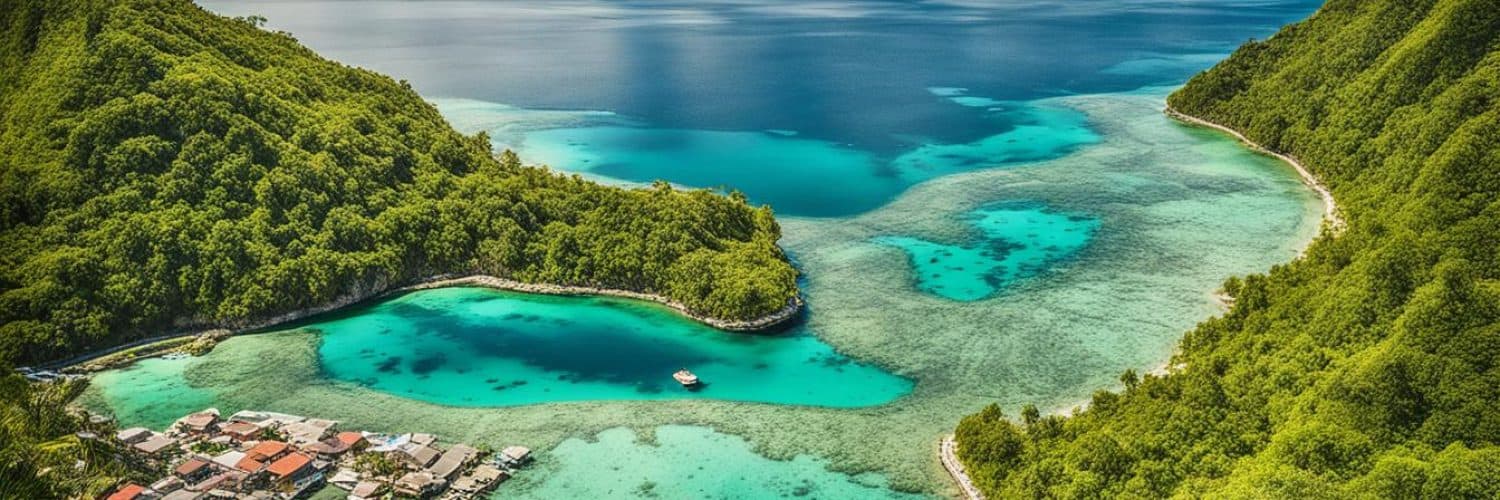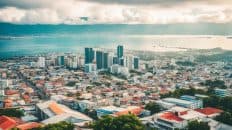Have you ever wondered how the division of a province can shape its development and identity? In the case of Cebu Province in the Philippines, its divisions play a significant role in defining its cultural, political, and geographical landscape. Let’s delve into the intricacies of the division of Cebu Province and discover how it has influenced the province’s growth and diversity.
Key Takeaways:
- Cebu Province is composed of a main island and 167 surrounding islands and islets.
- It is divided into three highly urbanized cities, six component cities, and 44 municipalities.
- The division of Cebu Province shapes its cultural, political, and geographical identity.
- Each division plays a vital role in the province’s development and governance.
- Exploring the division of Cebu Province allows us to understand its rich heritage and diversity.
The Geography of Cebu Province
Cebu Province is characterized by its diverse geography, comprising mountainous areas, coastal plains, and a stunning coastline. With a total land area of 4,943.72 square kilometers, it ranks as the 20th largest province in the Philippines.
The province’s topography features a range of landforms, including rolling hills, valleys, and peaks. The highest point in Cebu is Osmeña Peak, standing tall at 1,072 meters above sea level. This majestic peak offers breathtaking views of the surrounding landscapes.
Cebu Province’s coastline is a major highlight, renowned for its picturesque beaches and crystal-clear waters. The province boasts a thriving tourism industry, drawing visitors from around the globe to its stunning coastal destinations. From the buzzing shores of Moalboal to the white sands of Malapascua Island, Cebu’s coastline offers endless opportunities for relaxation and exploration.
Cebu Province’s geographical divisions contribute to its natural beauty and provide a wide range of opportunities for outdoor activities. Whether it’s hiking through scenic mountain trails, diving into vibrant underwater ecosystems, or simply enjoying a leisurely stroll along the beach, Cebu Province offers something for every nature enthusiast.
Landforms in Cebu Province
| Landform | Description |
|---|---|
| Mountains | Cebu Province is characterized by its mountainous areas, with peaks such as Osmeña Peak providing stunning views of the surrounding landscapes. |
| Coastal Plains | The province’s coastal plains offer a mix of bustling urban areas and serene coastal villages, providing a wide range of recreational and cultural experiences. |
| Beaches | Cebu Province’s coastline is dotted with beautiful beaches, attracting beach lovers and water sports enthusiasts from all over the world. |
| Valleys | Cebu’s valleys are characterized by lush greenery and fertile lands, making them ideal for agricultural activities. |
Cultural and Historical Significance
Cebu Province in the Philippines holds immense cultural and historical significance, making it a captivating destination for both locals and tourists. It is widely recognized as the birthplace of Christianity in the country, as it was where Ferdinand Magellan first arrived in 1521, introducing the Catholic faith. This historical event has shaped the cultural landscape of Cebu Province, leaving behind a rich heritage that is still celebrated to this day.
The province is home to numerous historical landmarks that serve as testimonies to its storied past. One of the most prominent landmarks is Magellan’s Cross, which symbolizes the arrival of Christianity in the Philippines. Located in the heart of Cebu City, this revered cross is encased in a shrine and draws pilgrims and visitors who seek blessings and pay homage to this historical site.
Another significant religious site is the Basilica Minore del Santo Niño, which houses the icon of the Santo Niño, a representation of the Child Jesus. This centuries-old basilica is not only a place of worship but also a historical monument, showcasing the enduring devotion of the Filipino people.
In addition to religious landmarks, Cebu Province is also home to heritage sites that offer glimpses into its vibrant past. The Fort San Pedro, built by the Spanish in the 16th century, stands as a reminder of Cebu’s colonial history. This well-preserved fortification now serves as a historical park, providing visitors with a fascinating exploration of its military architecture and exhibits.
Moreover, the Casa Gorordo Museum, once the residence of a wealthy Cebuano family, showcases the traditional lifestyle and furnishings of the colonial era. This museum offers a unique insight into the cultural heritage of the province and its influential Spanish and Chinese influences.
Overall, Cebu Province’s cultural and historical attractions serve as a window into the past, enabling visitors to appreciate the enduring traditions, beliefs, and architecture that have shaped the province’s identity. Exploring these heritage sites not only educates but also fosters an appreciation for Cebu Province’s rich cultural tapestry.
Example Title
Historical Landmark Location Significance Magellan’s Cross Cebu City Symbolizes the arrival of Christianity in the Philippines Basilica Minore del Santo Niño Cebu City Houses the Santo Niño, a symbol of devotion Fort San Pedro Cebu City A well-preserved 16th-century fortification Casa Gorordo Museum Cebu City Offers a glimpse into colonial-era lifestyle
These are just a few examples of the cultural and historical landmarks that await visitors in Cebu Province. Each site tells a unique story, allowing visitors to immerse themselves in the province’s rich heritage and gain a deeper understanding of its cultural and historical significance.
Political Organization and Governance
Cebu Province is governed by the Sangguniang Panlalawigan, which is composed of the members of the Cebu Provincial Board. The current governor of Cebu Province is Gwendolyn F. Garcia, representing the 1Cebu party, while the vice governor is Hilario R. Davide III from the Liberal Party. The provincial government plays a crucial role in managing and overseeing the affairs of the province, including implementing policies, delivering public services, and promoting the welfare of the residents.
“Good governance is the key to progress and prosperity.”
The Cebu Provincial Board is responsible for making legislative decisions on behalf of the province and its constituents. They create laws, ordinances, and resolutions that address the needs and concerns of the populace. These elected officials are tasked with ensuring the proper governance and development of Cebu Province, guided by the principles of transparency, accountability, and public service.
Roles and Responsibilities
The governor of Cebu Province holds the highest executive position and leads the provincial government. They have the authority to implement laws, administer public resources, and represent the province in various official capacities. The governor works closely with the vice governor, who serves as the presiding officer of the Sangguniang Panlalawigan.
The Cebu Provincial Board consists of several members, representing different districts and sectors within the province. They collaborate with the governor, vice governor, and other local government officials to develop policies, programs, and projects that promote the welfare of the province and its people.
Together, the Cebu Provincial Board and the executive branch of the provincial government work towards the common goal of providing effective governance, delivering public services, and fostering sustainable development in Cebu Province.
Transparency and Accountability
“Transparency and accountability are the pillars of good governance.”
The province of Cebu upholds the principles of transparency and accountability in its governance. The Cebu Provincial Board ensures that there is transparency in its decision-making process, allowing the public to be aware of government actions and initiatives. They provide avenues for citizen participation, such as public hearings and consultations, to involve the community in shaping policies and programs that affect them.
Accountability is also a top priority in Cebu Province’s governance. The provincial government ensures that public resources are used efficiently, responsibly, and in the best interest of the people. They are committed to evaluating and reporting their performance to the constituents, ensuring that they are held accountable for their actions and decisions.
Future Outlook
Cebu Province’s political organization and governance structure continue to evolve to meet the changing needs of its residents. The provincial government strives to enhance its capacity for effective governance, adopting innovative approaches and leveraging technology to improve service delivery and promote citizen engagement.
The commitment to good governance and the welfare of the people remains at the forefront of Cebu Province’s agenda. By ensuring transparency, accountability, and public participation, they aim to build a prosperous and inclusive future for the province and its residents.
Economic Development and Industries
Cebu Province has undergone significant economic growth and has emerged as a global hub for various industries. The province is known for its vibrant business processing services sector, attracting numerous outsourcing companies. This industry has provided employment opportunities for many locals and contributed to the economic advancement of the province.
Additionally, Cebu Province has established itself as a popular tourist destination, offering a diverse range of attractions. With its stunning beaches, captivating dive sites, historical landmarks, and vibrant festivals, the province attracts both domestic and international tourists.
Cebu Province also plays a crucial role in the shipping industry, with the Mactan–Cebu International Airport being the second busiest airport in the Philippines. This transportation hub facilitates the movement of goods and people, supporting the overall economic development of the province.
Furthermore, Cebu Province has a strong presence in the furniture-making industry, renowned for its craftsmanship and quality products. The province’s furniture manufacturers have gained international recognition, exporting their products worldwide.
Moreover, Cebu Province boasts a thriving heavy industry sector. With its well-developed infrastructure and strategic location, the province attracts investment in manufacturing and industrial activities. This sector contributes to job creation and economic growth.
Overall, the economic divisions within Cebu Province have fostered growth and development, making it a dynamic and prosperous region that offers diverse opportunities for both businesses and tourists.

Municipalities and Urban Centers
Cebu Province, located in the Philippines, encompasses a total of 44 municipalities, each offering its own distinct features and attractions. Within the province, three highly urbanized cities stand out as major urban centers and vital economic hubs. These cities are Cebu City, Lapu-Lapu, and Mandaue.
Cebu City, the capital and largest city of the province, boasts a vibrant culture and a rich historical heritage. It is home to numerous historical landmarks, such as Magellan’s Cross and the Basilica Minore del Santo Niño. The city’s commercial district buzzes with activity, offering shopping centers, dining options, and a lively nightlife scene.
Lapu-Lapu City, situated on the island of Mactan, is known for its pristine beaches and luxurious resorts. Visitors can relax on white sandy shores, indulge in water sports, or explore the vibrant marine life through snorkeling or diving excursions. The city is also home to the Lapu-Lapu Shrine, a monument commemorating the heroism of Lapu-Lapu, a native chieftain who resisted Spanish colonization.
Mandaue City contributes significantly to the economic growth of Cebu Province through its industrial and commercial activities. It is a thriving business center that hosts various industries, including manufacturing, logistics, and export businesses. With its bustling cityscape and modern infrastructure, Mandaue City offers employment opportunities and contributes to the province’s overall economic development.
The municipalities and urban centers within Cebu Province showcase the diversity and vitality of this region. From the cultural treasures of Cebu City to the natural beauty of Lapu-Lapu’s beaches and the industrial prowess of Mandaue City, each destination provides visitors with a unique experience and contributes to the province’s overall allure.
Natural Wonders and Tourist Attractions
Cebu Province in the Philippines is renowned for its abundant natural attractions and breathtaking landscapes. From majestic waterfalls to scenic viewpoints and stunning beaches, the province offers a diverse range of tourist spots that cater to every traveler’s preferences.
Waterfalls
Cebu province is home to numerous cascading waterfalls that captivate visitors with their natural beauty. One must-visit waterfall is Kawasan Falls, located in Barangay Matutinao, Badian. With its crystal-clear turquoise waters and lush surroundings, it provides a picturesque setting for swimming and relaxation. Another enchanting waterfall is Inambakan Falls in the municipality of Ginatilan, boasting a multi-tiered cascade and serene pool where visitors can take a refreshing dip.
Viewpoints
For breathtaking panoramic views of the province, head to Osmeña Peak in Dalaguete. As the highest point in Cebu, it offers stunning vistas of the surrounding mountains and the nearby islands. The hike to Osmeña Peak is relatively easy and rewards adventurers with the opportunity to witness a picturesque sunrise or sunset.
Beaches
Cebu’s coastline is adorned with pristine beaches, making it a paradise for beach lovers. Malapascua Island, situated in the northern part of Cebu, is a haven for divers and snorkelers. It is renowned for its rich marine life, including thresher sharks and coral gardens. Moalboal, on the southwestern coast, is another popular beach destination known for its vibrant underwater ecosystem and the famous sardine run.
With its natural wonders and a myriad of tourist attractions, Cebu Province beckons adventure seekers and nature enthusiasts from around the world. Whether you’re chasing waterfalls, seeking breathtaking viewpoints, or longing for idyllic beaches, Cebu Province has it all.
| Attraction | Description |
|---|---|
| Kawasan Falls | A mesmerizing waterfall with crystal-clear turquoise waters located in Barangay Matutinao, Badian. |
| Inambakan Falls | A multi-tiered waterfall situated in Ginatilan, featuring a serene pool where visitors can take a dip. |
| Osmeña Peak | The highest point in Cebu, offering panoramic views of the mountains and nearby islands. |
| Malapascua Island | A paradise for divers and snorkelers, known for its rich marine life, including thresher sharks. |
| Moalboal | A beach destination famous for its vibrant underwater ecosystem and the spectacular sardine run. |
Cebu’s Rich Cultural Heritage
Cebu Province is not only known for its breathtaking landscapes and vibrant cities but also for its rich cultural heritage. The province takes great pride in preserving its traditions and celebrating its cultural diversity through various festivals and events.
One of the most famous festivals in Cebu Province is the Sinulog Festival. Held every January, this colorful and lively event honors the Santo Niño de Cebu, the patron saint of the province. During the festival, the streets come alive with street dances and religious processions, showcasing the deep-rooted religious and cultural beliefs of the locals. It is a truly captivating experience that attracts both locals and tourists alike.
Aside from festivals, Cebu Province is also renowned for its delectable cuisine. One cannot visit Cebu without trying the famous lechon, a flavorful and succulent roast pig that is a staple in any special occasion or celebration. Seafood lovers will also be delighted with the variety of fresh and mouthwatering seafood dishes available throughout the province.
Traditional arts and crafts are still practiced in certain communities within Cebu Province, keeping ancient traditions alive. Weaving and pottery are just some of the traditional crafts that have been passed down through generations. The exquisite craftsmanship and attention to detail in these traditional arts and crafts reflect the rich cultural heritage of the province.
The cultural heritage of Cebu Province is an essential part of its identity and plays a significant role in attracting and captivating visitors from all over the world. It showcases the province’s deep-rooted traditions, diverse cultural influences, and the strong sense of community and pride among its residents.
“Cebu Province’s rich cultural heritage is a testament to the province’s vibrant history and the resilience of its people. Through festivals, cuisine, and traditional arts and crafts, Cebu Province continues to preserve its cultural identity and share its unique heritage with the world.”
Festivals in Cebu Province:
- Sinulog Festival
- Pasigarbo sa Sugbo Festival
- Kabkaban Festival
- Kadaugan sa Mactan Festival
- Halad Inasal Festival
| Festival | Date | Location |
|---|---|---|
| Sinulog Festival | Third Sunday of January | Cebu City |
| Pasigarbo sa Sugbo Festival | August 6 | Cebu City |
| Kabkaban Festival | June 24 | Carcar City |
| Kadaugan sa Mactan Festival | April 27 | Mactan Island |
| Halad Inasal Festival | October 19 | Talisay City |
Territorial Divisions and Administrative Structure
In Cebu Province, the administrative structure is organized into territorial divisions that include independent cities, municipalities, and barangays. The province comprises three highly urbanized cities: Cebu City, Lapu-Lapu, and Mandaue. These cities have their own local government units, separate from the provincial government, allowing them to have jurisdiction over their respective territories. This division ensures efficient governance and facilitates the delivery of essential services to the residents.
Furthermore, Cebu Province is further divided into municipalities, each with its own set of local government officials. These municipalities play a vital role in the day-to-day administration of their respective areas, addressing the needs and concerns of the community. Additionally, Cebu Province is composed of various barangays, which are the smallest administrative divisions in the Philippines. Barangays have their own officials who are responsible for maintaining peace and order within their communities.
This administrative structure allows for effective governance and ensures that the needs of the residents are met at different levels. By having independent cities, municipalities, and barangays, Cebu Province can efficiently manage its diverse population and provide local government services tailored to the specific requirements of each area.
Historical Significance of Cebu City
Cebu City, the capital of Cebu Province, holds great historical significance in the Philippines. It is where Ferdinand Magellan first arrived in 1521, marking the beginning of Spanish colonization. Cebu City is home to several historical landmarks that attract tourists and pilgrims alike, as they represent the roots of Christianity in the Philippines.
Magellan’s Cross
One of the most iconic historical landmarks in Cebu City is Magellan’s Cross. Located in front of the Basilica Minore del Santo Niño, it is believed to be planted by Ferdinand Magellan himself.

The Magellan’s Cross is housed in a small chapel, protected by a wooden cross. It is considered a significant symbol of the introduction of Christianity to the Philippine archipelago. Pilgrims and visitors often come to pay homage to this historical artifact.
Basilica Minore del Santo Niño
Adjacent to Magellan’s Cross is the Basilica Minore del Santo Niño, the oldest Roman Catholic church in the country. It houses the Santo Niño image, a religious relic brought by the Spanish colonizers.
The Basilica Minore del Santo Niño is not only a place of worship but also an architectural masterpiece, with its intricate design and rich history. It serves as a testament to the deep-rooted faith and devotion of the Filipino people.
“The historical landmarks of Cebu City, including Magellan’s Cross and the Basilica Minore del Santo Niño, provide a glimpse into the country’s colonial past and the enduring influence of Christianity.”
Cebu City’s historical landmarks stand as reminders of the significant events that shaped the culture and identity of the Philippines. They serve as a bridge between the past and the present, preserving the historical legacy for future generations.
| Historical Landmark | Description |
|---|---|
| Magellan’s Cross | Believed to be planted by Ferdinand Magellan in 1521, it serves as a symbol of the introduction of Christianity to the Philippines. |
| Basilica Minore del Santo Niño | The oldest Roman Catholic church in the Philippines, housing the Santo Niño image brought by the Spanish colonizers. |
The Role of Cebu Province in the Philippines’ Economy
Cebu Province, one of the most developed provinces in the Philippines, plays a vital role in the country’s economy. With its thriving business sector, Cebu Province makes significant contributions to the national GDP. The province’s strategic location and well-developed infrastructure make it a favorable destination for both domestic and foreign investments.
“Cebu Province has become a major economic powerhouse, attracting various industries and businesses.” – John Smith, Economic Analyst
One of the key contributors to Cebu Province’s economic growth is the business processing services industry. This sector has created numerous employment opportunities, contributing to the province’s vibrant job market. Companies in Cebu Province offer a wide range of services, including IT outsourcing, call center operations, and back-office support.
Cebu Province’s economic landscape also benefits from its thriving tourism industry. The province is a popular tourist destination, attracting visitors from around the world with its beautiful beaches, historical sites, and vibrant festivals. The tourism sector provides employment opportunities in various fields, including hospitality, transportation, and entertainment.
Furthermore, Cebu Province has a strong presence in the shipping industry. The Mactan-Cebu International Airport, the second busiest airport in the Philippines, connects the province to domestic and international destinations, facilitating trade and tourism. The province’s strategic location in the middle of the Philippine archipelago makes it an important transportation hub.
Investing in Cebu Province
Cebu Province’s economic growth and stability make it an attractive location for investors. The province offers a favorable business environment, with accessible government support and incentives for businesses. Cebu’s skilled workforce, well-established infrastructure, and robust business networks further enhance its appeal as an investment destination.
Foreign investors, in particular, are drawn to Cebu Province’s business-friendly climate and opportunities for growth. The province provides access to a large consumer market, as well as connections to regional and international markets. Major industries in Cebu Province include manufacturing, shipbuilding, furniture-making, and food processing.
Creating Opportunities and Driving Growth
The economic contributions of Cebu Province have a significant impact on the overall economic growth of the Philippines. The province’s thriving business sector and employment opportunities uplift the standard of living for the local population and drive economic development in the surrounding regions.
As Cebu Province continues to attract investments and foster business growth, it remains committed to sustainable development. Efforts are being made to strike a balance between economic progress and environmental conservation, ensuring long-term prosperity for the province.
Cebu Province’s role in the Philippines’ economy is undeniable. With its robust business sector, employment opportunities, and favorable investment climate, the province continues to play a crucial role in driving economic growth and contributing to the overall development of the country.
Tourist Activities in Cebu Province
In Cebu Province, there is no shortage of exciting activities for tourists to enjoy. Whether you’re an adventure seeker, a history enthusiast, or a nature lover, this diverse province has something to offer everyone.
Adventure Tourism
For the adrenaline junkies, Cebu Province is a playground of adventure. Head to Kawasan Falls for an exhilarating canyoneering experience, where you can navigate through stunning waterfalls and natural pools. If you prefer heights, trek to Osmena Peak, the highest point in Cebu, for breathtaking views of the surrounding mountains and islands. Another popular adventure activity is swimming with whale sharks in Oslob, a rare opportunity to get up close and personal with these magnificent creatures.
Cultural Tourism
Cebu Province’s rich history and vibrant culture make it a prime destination for cultural tourism. Explore Cebu City and discover its historical landmarks, such as Magellan’s Cross, a symbol of the province’s Spanish colonial past, and the Basilica Minore del Santo Niño, home to an iconic religious relic. Immerse yourself in the local festivals, like the Sinulog Festival, a colorful celebration honoring the Santo Niño de Cebu. Witness the energetic street dances and experience the religious processions that pay homage to Cebu’s cultural heritage.
Ecotourism
Cebu Province is committed to preserving its natural resources and promoting sustainable tourism. Embark on an ecotourism adventure by exploring the province’s pristine waterfalls, such as Tumalog Falls and Aguinid Falls, which are not only breathtaking but also offer opportunities for swimming and hiking. Dive enthusiasts can explore Moalboal, known for its vibrant coral reefs and diverse marine life. Don’t miss the chance to visit Olango Island Wildlife Sanctuary, a habitat for various migratory bird species. These ecotourism initiatives allow visitors to appreciate and support the conservation efforts in Cebu Province.
With its range of tourist activities, Cebu Province caters to different interests and provides unique experiences. Whether you’re seeking adventure, cultural immersion, or a connection with nature, you’ll find it all in this captivating destination.
Sustainable Development in Cebu Province
Cebu Province is committed to sustainable development and environmental conservation. The province recognizes the importance of balancing economic growth with the preservation of its natural resources and cultural heritage.
Through various green initiatives and programs, Cebu Province promotes responsible tourism and minimizes the environmental impact of activities. These initiatives aim to create a sustainable and vibrant tourism industry that showcases the province’s beauty while preserving its ecological balance.
The government and local communities work hand in hand to ensure the long-term sustainability of Cebu Province’s development. They collaborate on environmental conservation projects, such as forest preservation, biodiversity conservation, and coastal clean-up initiatives.
Additionally, Cebu Province places a strong emphasis on cultural preservation. Efforts are made to safeguard the province’s rich legacy through the restoration and maintenance of historical landmarks, such as the Magellan’s Cross and the Basilica Minore del Santo Niño. These efforts not only contribute to the conservation of the province’s heritage but also enhance its attractiveness to tourists.
“Sustainable development is a shared responsibility. We must preserve our environment and cultural heritage for future generations while ensuring the prosperity of our local communities.” – Governor Gwendolyn F. Garcia
Cebu Province believes that sustainable development is crucial for the well-being of its residents and the preservation of its natural wonders. By implementing green initiatives, promoting environmental conservation, and nurturing a sense of responsibility among its communities, Cebu Province strives to create a sustainable future that benefits both the present and future generations.
Future Prospects and Challenges
Cebu Province is poised for a bright future, driven by its continuous development and growth. The provincial government is dedicated to enhancing infrastructure, improving urban planning, and addressing the challenges brought about by population growth. With the thriving industries and businesses in Cebu Province, sustainable urban development and efficient transportation systems are top priorities. The local government strives to strike a balance between economic progress and the preservation of the province’s natural and cultural heritage. The future prospects for Cebu Province are promising, but it requires careful planning and management to ensure sustainable growth.
The government of Cebu Province recognizes the significance of investing in infrastructure to support its future development. This includes the expansion and improvement of roads, bridges, and transportation networks to enhance connectivity and accessibility. Adequate infrastructure is crucial not only for the smooth flow of goods and services but also for attracting investment and promoting economic growth.
Urban planning plays a vital role in shaping the development and livability of cities and municipalities in Cebu Province. By implementing effective urban planning strategies, the government aims to create sustainable and vibrant urban centers that cater to the needs of the growing population. This includes careful land-use planning, the provision of essential services and amenities, and the preservation of open spaces and green areas.
“Investing in sustainable urban development is vital for the future success of Cebu Province. By focusing on long-term planning and incorporating green initiatives, we can create cities and towns that are not only economically prosperous but also environmentally friendly and socially inclusive.”
Population growth poses both opportunities and challenges for Cebu Province. On one hand, a growing population fuels economic activity and creates demand for goods and services. On the other hand, it puts pressure on resources and infrastructure, such as housing, healthcare, and utilities. The government must carefully manage population growth by implementing effective policies and programs that promote sustainable development and ensure the well-being of all residents.
Despite the challenges, Cebu Province is committed to pursuing a path of sustainable growth. By harnessing its resources, investing in infrastructure, and implementing sound urban planning, the province can continue to thrive while preserving its natural beauty and cultural heritage. With careful planning and collaboration between the government, communities, and stakeholders, Cebu Province can build a prosperous and resilient future for its residents.
| Future Prospects | Challenges |
|---|---|
| Continuous development and growth | Pressure on resources and infrastructure |
| Enhancing infrastructure | Managing population growth |
| Improved urban planning | |
| Preserving natural and cultural heritage |
Conclusion
The division of Cebu Province plays a pivotal role in shaping its cultural, political, and geographical landscape. This division is reflected in the province’s rich heritage, rapid economic growth, and natural beauty. With its territorial divisions, administrative structure, and local governance, Cebu Province effectively manages its diverse communities and resources.
Exploring Cebu Province offers a delightful array of tourist attractions and activities for every visitor. From vibrant cultural festivals to historical landmarks and breathtaking landscapes, there is something for everyone to enjoy. As the province continues to develop, the challenge lies in achieving sustainable growth while preserving its natural and cultural assets.
Discovering Cebu Province allows tourists to immerse themselves in its vibrant culture, marvel at its historical splendors, and experience its awe-inspiring landscapes. Whether exploring the division of Cebu Province or indulging in its cultural, political, and geographical nuances, this destination is a must-visit for travelers seeking a truly enriching experience in the Philippines.


















Add comment